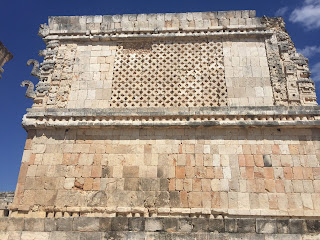We're currently ensconced in a beautiful hotel in Guanajuato,
Quinta de las Acacias. This feels way too luxurious for us but we'll try to endure it. If you click on the link there is an option to view 360 degree pictures of different parts of the hotel. It'll give you a pretty good idea of the beauty of this place.
We've now been in Mexico for 21 days and will be flying to Phoenix in two days. From there we'll visit our daughter in Tucson for four days and then fly back home on February 28.
So far we've spent twelve days in Merida, six in Mexico City and four in
Guanajuato. (Here's a
video of Guanajuato street scenes. Part of the video was taken while riding a funicular. Last section are scenes from our hotel. Music is by the Nicaraguan duo
Guardabarranco. The video link seems to want to start in the middle. You may have to slide the button to the beginning)
We've done so much since my last post it's hard to know where to begin. I'll use my photo file as a tool to help me remember key events and reactions.
Merida was hot (mid 90s) during the day but very pleasant mornings and evenings. Once again, the most memorable thing about this town, as is seems to always be in Mexico, is the kindness and friendliness of the Mexican people.
Memorable activities included attending a first class concert at the
Teatro Peon Contreras. Pieces performed included works by Gershwin, Copland and Beethoven. Quality performances in a distinctive, beautiful, historic venue. It seems every city we visit in Mexico has a very fancy turn-of-the-century
teatro. Here's a couple of pics of the Merida's version.
Much of our time in Merida was spent walking back and forth from the always interesting Plaza Grande in the cool of the morning or evening.
 |
| Walking through the shade in Merida's Plaza Grande |
We went on three day-long tours. The first was to two Mayan archeological sites
Uxmal and
Kabah
Uxmal was a major Mayan center. It's one of many complex, interesting sites throughout
Mesoamerica.
During this trip I've developed a much better idea of what is meant by "Mesoamerica" Much of this better understanding comes from our visit to the world class
Museo Nacional de Anthropologia in Mexico City. It helped me understand how the complex civilizations of Mesoamerica evolved and interrelated and gave me a sense of how deeply these indigenous cultures shape the Mexico's national identity.
In the U.S. Native American culture is much less of a factor because, unlike Mexico, most of our population has been generated by immigration. This line of thinking led me to the conclusion that the main unifying identity in the U.S., the fabric that, in large part, gives shape and meaning to our nation, is our immigrant heritage,
Mexico seems to understand the importance of recognizing and honoring its historical roots while today the US finds its immigrant heritage being threatened as never before. Opportunistic fearmongers have spread a toxic cloud of fear, divisiveness and uncertainty that is causing many of our fellow citizens to turn their backs on this proud and important heritage.
Next post - flamingos, cenotes, and the big manzana.
















